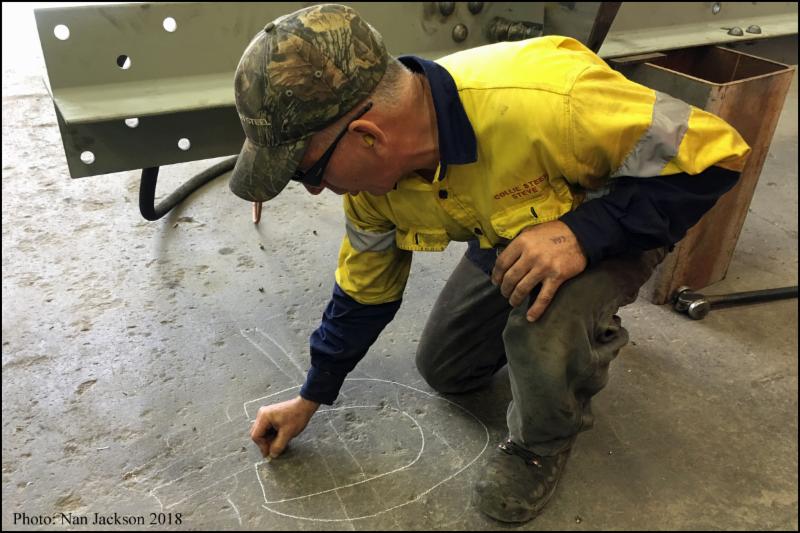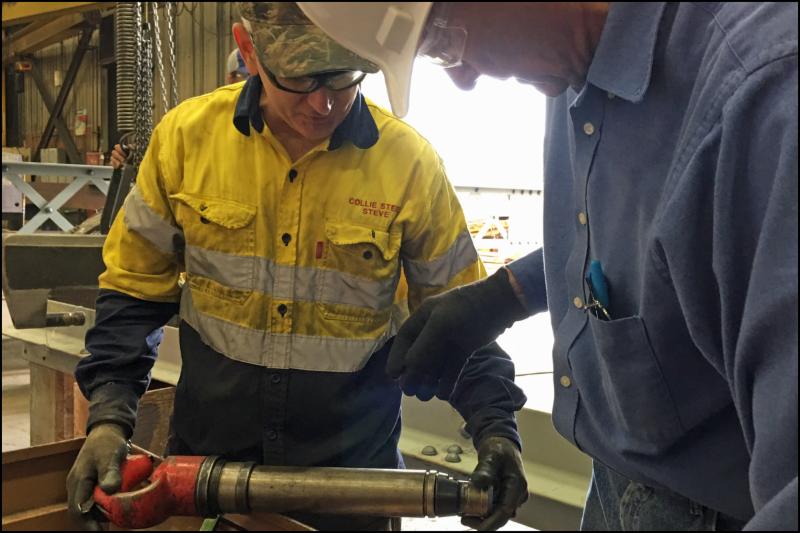 |
Iron & Steel Preservation
|
|

.
|

All things have a historic record. The value of this record is what we learn from its existence and how it's applied to any future application. This record may be in words, pictures, or a historic metal structure. Does this historic structure have any connection with programing a CNC machine, building a robot, or designing a transportation system for the 22nd century? The answer may be in an educated young mind of a person who can see a connection through a visual experience. Preservation can be something more than preserving history -- it can also inspire an idea where none was seen by those who accept things as they are.
Vern Mesler
Iron & Steel Preservation Coordinator
Lansing Community College
|
Cut River Bridge Repairs
(Heath M. Robinson Memorial Cut River Bridge)
Mackinac County, Michigan
|
"It honors the intent of the original engineering design and craftsmen that fabricated and erected the structure."
Lloyd Baldwin, cultural and historic resource coordinator for MDOT, comments on the replication of riveted structural members for the Cut River Bridge in Michigan's Upper Peninsula. The MDOT project involves painting, structural steel repairs, miscellaneous road repairs and the replication of riveted sections that will preserve this structure as an accurate historic record as well as a functioning bridge for highway vehicular traffic. Baldwin has been an early advocate for field rivet repairs and the replication of riveted sections for the replacement of worn or damaged sections on the Cut River Bridge. The shop-riveting done at Wisconsin Structural Steel Company in Barronett, Wisconsin, is an innovative approach to the preservation of historic riveted truss bridges currently in service. "The MDOT - State Historic Preservation Office (SHPO) collaboration is achieving successful projects that balance the historic preservation standards with current safety and performance standards," Baldwin notes. [read more]
In July, my wife Nan Jackson and I traveled to Barronett to tour the Wisconsin Structural Steel Company/LeJeune Steel to observe the shop riveting being done by Steve Howell of Ballard Forge, Seattle, Washington. The next day we visited the Cut River Bridge job site to view where a pack rust removal procedure will be performed.
During our visit at WISSCO, Plant Manager Brad Fox led us on an informative and spirited tour of the plant production facilities. Fox described the integration of advanced Peddinghaus CNC machinery with shop floor fabrication production, featured in Peddinghaus, Steel Fabrications' Review, Autumn 2011, as "Textbook Bridge Fabrication": "Together with their heavy fabrication division, Wisconsin Structural Steel, LeJeune, is a prime example of what modern technology and traditional craftsmanship can do in today's economy."
We would like to thank those who made it possible for us to visit the Wisconsin Structural Steel Company (Brad Fox and Steve Howell) and the Cut River Bridge job site (Chris Rupinski, MDOT Engineer Manager, Newberry TSC; and Stacy Sutela, MDOT Bridge Inspector, Newberry TSC).
|
Bolted rivet assemblies and completed rivet section at the Wisconsin Structural Steel Company.
|

Steve Howell's soapstone communication,
the mark of a true steel fabricator.
|

Steve describes the hydraulic press he custom built for the Cut River Bridge project.
|
|
Heating a rivet is an art, where sight, sound, and the working knowledge of steel is vital for a craftsman to tell when a rivet is ready to drive.
"I would say that if you drive it on the lower end of the heat spectrum you win from less scale and I believe a greater work hardening of the rivet," Howell says. Combined with shop knowledge and from studying articles and books on the subject of riveting, Howell has mastered the art of heating and driving rivets. His forge for heating rivets is simple but efficient, his handcrafted burner requires no external blowers or compressed air supply and will bring the rivet to dull orange, ideal for press-driven rivets.
Howell describes himself as a "tinkerer/ inventor type," and his custom-built hydraulic riveter built for the Cut River Bridge project is testament to his skills as a steel fabricator.
|

Howell's solidly built riveter drives 7/8" rivets; it accommodates sections of back-to-back 6" angles.
|

Where required, Howell drives rivets with a classic field rivet hammer.
|
|
As you drive east along U.S. Highway 2 in the Upper Peninsula and you cross the Cut River Bridge, you will see to your right a spectacular view of Lake Michigan. In another thirty miles is the Mackinac Bridge, Michigan's most famous bridge, connecting the Upper and Lower Peninsulas. In the quick drive across the Cut River Bridge, with the spectacular view of Lake Michigan and the anticipation of crossing the Mighty Mac, you may miss a chance to enjoy a sight not visible from the highway: a gorge cut deep by the Cut River, a forest of tall trees, sand dunes, textured sounds of a natural and man-made setting, all within the anchored ends of the stunning cantilevered trusses. Access to this remarkable view is by wooden stairs, walking paths, and trails that lead to the bottom of the gorge and the water's edge of Lake Michigan.
|
|
Ross Brown (Cutler General Store Village Blacksmith & Antiques) is a craftsman and blacksmith from Indiana with extensive skills and knowledge in the restoration of historic riveted truss bridges. Brown, along with crew members from ANLAAN, are doing the on-site field riveting and pack rust removal.
|
Cut River Bridge job-site: pictured below from left to right are Stacy Sutela (MDOT Bridge Inspector), Vern Mesler, and Jayson Johnson (Superintendent, ANLAAN Corporation)
|
Elk Mountain, Wyoming
-
RIP Old Bridge
|
|
Attention: Architects and Engineers
|
Exposed historic brick walls, riveted columns, trusses, early twentieth century warehouses, factories, and historic structures: today many are being re-purposed, some renovated for businesses that allow the public to enjoy historic spaces not found in the blight of sameness that urban sprawl has to offer.
Many of these historic structures, valued for their industrial look, could be enhanced by incorporating new riveted elements in these renovated or re-purposed buildings: additional riveted columns and trusses in a craft beer brewery; riveted bar features in a hotel located in a restored historic building; riveted exterior structures that complement a park shelter or the entrance to a building; a new pavilion fabricated with riveted trusses. The only limitation for designing new riveted structures is the designer's imagination.
Riveting will never return to its historic prominence or compete with the bolted or welded connections used on bridges and buildings today, but riveted members can complement new construction or enhance a re-purposed/renovated building. There are steel fabricators and blacksmiths today proficient in the hot riveting process who are able to do this work, fabrication of metal structures with rivets.
Re-educating the industrial community to do riveting as part of new construction can have the additional benefit of providing those responsible for making the decision for saving a historic riveted structure (bridge or building) with the knowledge that the industrial community has the expertise to perform both the engineering and fabrication service required for riveting.
For those engineers and architects who would like to explore design ideas for new riveted structures, I'm available to meet to review technical and fabrication questions.
|
|
2019 Preservation Workshop at Lansing Community College
|
Lansing Community College Iron & Steel Preservation (ISP) Workshops have provided one of the leading experiences for hands-on participation, demonstrations and technical papers in the preservation of metal structures. Workshop participants are introduced to the preservation of iron and steel using the electric arc welding processes, braze welding processes and an introduction to the industrial riveting process. They experience the use of these and other industrial processes and learn how these processes have important applications in the preservation of historic metals. The next ISP Workshop will be in the fall of 2019 at Lansing Community College. It will feature preservation work on notable projects in the United States (including the re-purposing and renovation of historic buildings) and current work on Michigan historic bridges.
New in ISP 2019:
In addition to the preservation of historic metal structures, demonstrations for new riveted structures will be presented. As noted above (Attention: Architects and Engineers), new construction
can be enhanced by incorporating new riveted elements in renovated or re-purposed buildings: riveted exterior structures that complement a park shelter or the entrance to a building; a pavilion fabricated with riveted trusses, etc.
An invitation is being extended to preservation organizations, corporations, and individuals to support the 2019 ISP Workshop through student scholarships or funding for the workshop activities. Please contact Vern Mesler to discuss sponsorship opportunities.
|
|
Program Fund
Please consider contributing to the Iron and Steel Preservation Program Fund. This fund was established to support projects, research, conferences and scholarships related to the repair, rehabilitation, and restoration of metals. The Lansing Community College Foundation is a nonprofit 501(c)(3) corporation.
Donate Here
|
|
|
|
Past Iron & Steel Preservation Newsletters
|
|
|
|
Sponsor
|
Want to become a sponsor?
|
|
Lansing Community College
5708 Cornerstone Drive
PO Box 40010
, MC 4100W
Lansing, MI 48917
|
|
|
|
|
Copyright © 2018. All Rights Reserved.
|
|
|
|